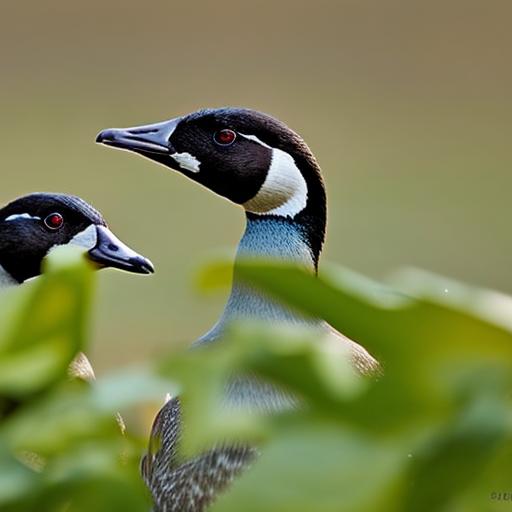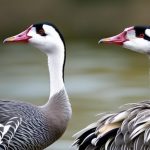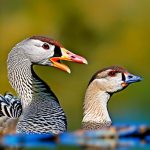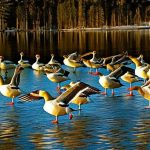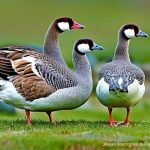The Canada Goose problem in spring crops has become a growing concern for farmers across North America. These large birds are attracted to crop fields during the spring season, causing significant damage to crops and impacting farmers’ livelihoods. It is crucial for farmers to understand the reasons behind the Canada Goose problem and take proactive measures to manage their populations in crop fields.
Key Takeaways
- Canada geese can cause significant damage to spring crops, leading to economic losses for farmers.
- The most common Canada goose species found in crop fields are the Canada goose and the cackling goose.
- Canada geese can impact crop production by consuming and trampling crops, as well as contaminating fields with their droppings.
- Preventative measures such as physical barriers, scare tactics, and repellents can be effective in keeping Canada geese out of crop fields.
- Habitat modification and collaboration with wildlife experts can also play a role in managing Canada goose populations in spring crops.
Understanding the Canada Goose Problem in Spring Crops
Canada Geese are attracted to crop fields in the spring for several reasons. Firstly, these fields provide an abundant food source for the birds, including young shoots, seeds, and insects. Additionally, crop fields often offer open spaces for nesting and protection from predators. The presence of water sources nearby, such as ponds or rivers, further attracts Canada Geese to crop fields.
The impact of Canada Geese on crop production can be significant. These birds feed on young shoots and leaves, causing damage to emerging crops. They also trample on plants, leading to reduced yields and stunted growth. Furthermore, their droppings can contaminate crops, posing health risks for humans and livestock.
Identifying the Most Common Canada Goose Species in Crop Fields
There are several species of Canada Geese that can be found in crop fields. The most common species include the Canada Goose (Branta canadensis), the Cackling Goose (Branta hutchinsii), and the Lesser Canada Goose (Branta canadensis parvipes). These species vary in size and plumage, making it important for farmers to be able to identify them accurately.
The Canada Goose is the largest of the three species, with a black head and neck, white cheeks, and a brownish-gray body. The Cackling Goose is smaller in size, with a dark brown body and a short neck. The Lesser Canada Goose is similar in appearance to the Canada Goose but is smaller in size.
The Impact of Canada Geese on Spring Crop Production
The damage caused by Canada Geese to spring crops can be devastating for farmers. These birds feed on young shoots and leaves, which can stunt the growth of crops and reduce yields. Additionally, their trampling can damage plants and make them more susceptible to disease and pests. The droppings left behind by Canada Geese can contaminate crops, making them unsafe for consumption.
The economic impact of Canada Goose damage on farmers is significant. Crop losses can result in financial losses for farmers, affecting their livelihoods and the local economy. Furthermore, the cost of implementing control measures to manage Canada Goose populations can be substantial. It is crucial for farmers to take proactive steps to prevent and mitigate the damage caused by these birds.
Preventing Canada Geese from Entering Crop Fields
Preventing Canada Geese from entering crop fields is an essential step in managing their populations. There are several effective methods that farmers can employ to deter these birds. Firstly, it is important to remove any potential food sources from the fields, such as spilled grain or leftover crops. This will make the fields less attractive to Canada Geese.
Another effective method is to create physical barriers around the crop fields. Fencing or netting can be used to prevent Canada Geese from accessing the fields. It is important to ensure that the barriers are tall enough and secure enough to deter the birds. Additionally, scare devices such as scarecrows or reflective tape can be placed around the fields to frighten Canada Geese away.
Using Physical Barriers to Keep Canada Geese Out of Spring Crops

Physical barriers are an effective way to keep Canada Geese out of crop fields. There are several types of barriers that farmers can use, each with its own pros and cons.
Fencing is a common method used to keep Canada Geese out of crop fields. Electric fencing can be particularly effective, as it provides a mild shock to deter the birds. However, it is important to ensure that the fencing is tall enough and properly maintained to prevent Canada Geese from flying over or digging under it.
Netting is another option for keeping Canada Geese out of crop fields. This method involves covering the entire field with a net, preventing the birds from accessing the crops. However, netting can be expensive and time-consuming to install and maintain.
Implementing Scare Tactics to Deter Canada Geese
Scare tactics can be an effective way to deter Canada Geese from crop fields. There are several scare devices that farmers can use, each with its own advantages and disadvantages.
Scarecrows are a traditional scare tactic that can be effective in deterring Canada Geese. These human-like figures can be placed strategically around the fields to frighten the birds. However, Canada Geese can become accustomed to scarecrows over time, so it is important to move them regularly.
Reflective tape is another scare tactic that can be used to deter Canada Geese. This tape reflects light and creates a visual deterrent for the birds. It can be hung around the perimeter of the fields or tied to stakes throughout the field. However, reflective tape may lose its effectiveness over time as Canada Geese become accustomed to it.
Using Repellents to Keep Canada Geese Away from Spring Crops
Repellents can be an effective tool in keeping Canada Geese away from crop fields. There are several types of repellents that farmers can use, each with its own pros and cons.
Chemical repellents are one option for deterring Canada Geese. These repellents are applied directly to the crops and emit an odor or taste that is unpleasant to the birds. However, chemical repellents may not be suitable for all crops and can be harmful to other wildlife.
Acoustic repellents are another option for keeping Canada Geese away from crop fields. These devices emit loud noises or distress calls that frighten the birds. However, acoustic repellents may not be effective in all situations and can be disruptive to neighboring properties.
The Role of Habitat Modification in Managing Canada Goose Populations
Habitat modification can be an effective tool in managing Canada Goose populations. By altering the habitat to make it less attractive to the birds, farmers can reduce the likelihood of Canada Geese entering crop fields.
One method of habitat modification is to remove or reduce water sources near the fields. Canada Geese are attracted to water for nesting and protection from predators. By eliminating or reducing water sources, farmers can make the area less appealing to the birds.
Another method is to create alternative habitats for Canada Geese away from crop fields. This can be done by providing nesting structures or creating wetland areas nearby. By providing suitable habitats elsewhere, farmers can encourage Canada Geese to stay away from their crops.
Monitoring and Evaluating Canada Goose Control Measures
Monitoring and evaluating Canada Goose control measures is crucial in determining their effectiveness. By regularly assessing the success of these measures, farmers can make adjustments as needed and ensure that they are effectively managing Canada Goose populations.
One way to monitor control measures is through regular field inspections. Farmers can assess the presence of Canada Geese in their fields and evaluate any damage caused. Additionally, farmers can keep track of any changes in bird behavior or population size.
Evaluating the effectiveness of control measures can be done through data collection and analysis. Farmers can record the number of Canada Geese present in their fields before and after implementing control measures. They can also track crop yields and assess any changes in damage caused by the birds.
Collaborating with Wildlife Experts to Manage Canada Goose Populations in Spring Crops
Collaborating with wildlife experts is essential in effectively managing Canada Goose populations in spring crops. These experts have the knowledge and experience to provide guidance and support to farmers.
Finding wildlife experts can be done through local government agencies, universities, or conservation organizations. These experts can provide advice on the best control measures to implement and help farmers develop a comprehensive management plan.
Working with wildlife experts also allows farmers to stay up-to-date on the latest research and techniques for managing Canada Goose populations. By staying informed, farmers can make informed decisions and ensure that they are using the most effective methods available.
Managing Canada Goose populations in spring crops is crucial for farmers to protect their livelihoods and ensure the success of their crops. By understanding the reasons behind the Canada Goose problem and implementing proactive measures, farmers can prevent and mitigate the damage caused by these birds. It is important for farmers to take action and collaborate with wildlife experts to effectively manage Canada Goose populations in their crop fields.
If you’re looking for ways to keep Canada geese out of your spring crops, you might find this article on poultrywizard.com helpful. It provides valuable insights and tips on how to protect your crops from these pesky birds. Additionally, if you’re interested in keeping chickens as a natural deterrent, you can check out their article on “The Chicken Coop Country Diner” for more information. Click here to read the article and discover effective strategies to safeguard your spring crops.
FAQs
What are Canada geese?
Canada geese are large water birds that are native to North America. They are known for their distinctive honking calls and V-shaped flight formations.
Why do Canada geese pose a problem for spring crops?
Canada geese are herbivores and can cause significant damage to crops by feeding on young plants and seedlings. This can result in reduced crop yields and financial losses for farmers.
What are some methods for keeping Canada geese out of spring crops?
Some effective methods for keeping Canada geese out of spring crops include using scare tactics such as loud noises or visual deterrents like reflective tape or decoys. Physical barriers like fencing or netting can also be effective.
Are there any humane methods for keeping Canada geese out of spring crops?
Yes, there are several humane methods for keeping Canada geese out of spring crops. These include using non-lethal deterrents like noise makers or visual deterrents, as well as providing alternative food sources for the geese to reduce their reliance on crops.
Is it legal to harm or kill Canada geese?
Canada geese are protected under the Migratory Bird Treaty Act, which makes it illegal to harm or kill them without a permit. It is important to use humane methods for keeping Canada geese out of spring crops and to consult with local wildlife authorities for guidance.
Meet Walter, the feathered-friend fanatic of Florida! Nestled in the sunshine state, Walter struts through life with his feathered companions, clucking his way to happiness. With a coop that’s fancier than a five-star hotel, he’s the Don Juan of the chicken world. When he’s not teaching his hens to do the cha-cha, you’ll find him in a heated debate with his prized rooster, Sir Clucks-a-Lot. Walter’s poultry passion is no yolk; he’s the sunny-side-up guy you never knew you needed in your flock of friends!

